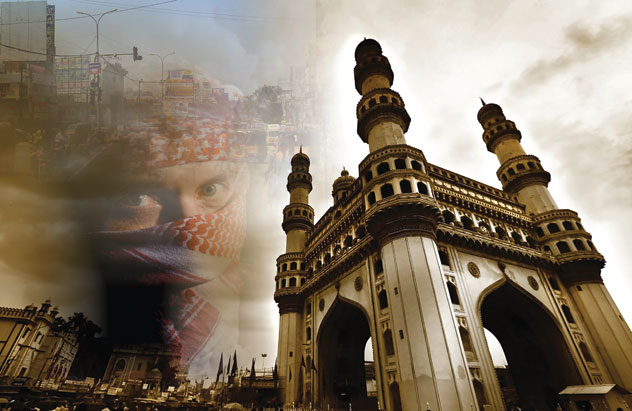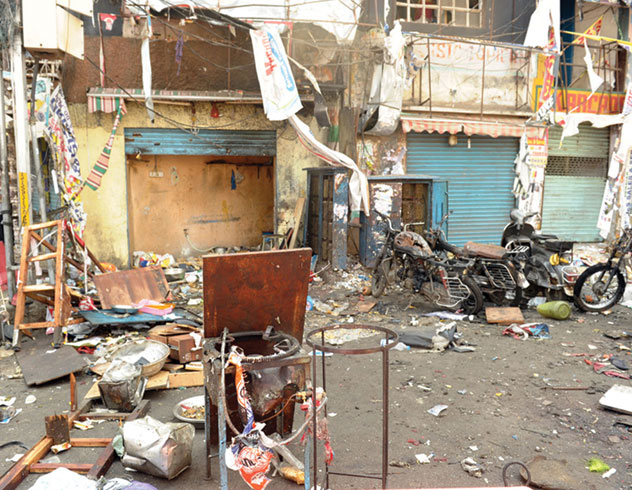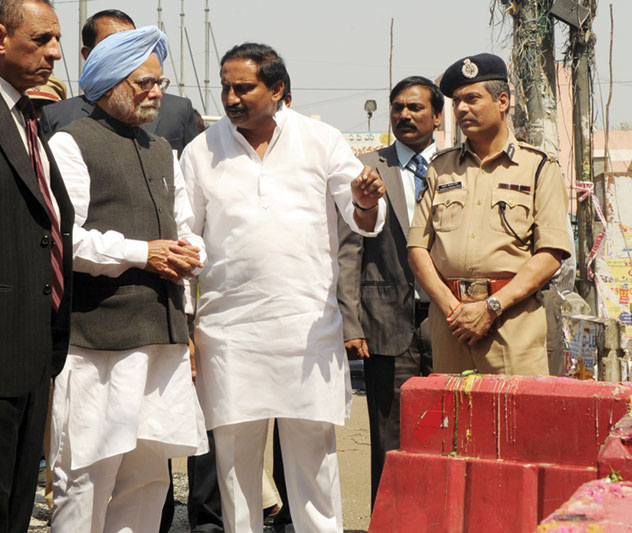CURRENT AFFAIRS:
Terror Killings: Devastate Hyderabad Peace
The twin blasts on Feb. 21, near a bus stop and a cinema hall in Dilsukhnagar area of Hyderabad, state capital of Andhra Pradesh reconfirms that the phenomenon of terrorism in India is far from suppressed, writes Priyanka Bhardwaj.
 [Photo: Siliconeer graphic] [Photo: Siliconeer graphic]
The latest attack that left 16 dead and more than 120 grievously injured besides damaging humongous property came close on the heels of vitriolic speeches given by controversial leaders, Majlis-e-Ittehadul Muslimeen MLA Akbaruddin Owaisi and senior Vishwa Hindu Parishad leader Praveen Togadia, and hanging of the December 2001 Parliament attack convict Afzal Guru.
The bombing was carried out on a weekday (Thursday) close to the Sai Baba temple when hordes of devotees collected to worship at a peak hour ensuring maximum casualty and maximum media coverage of the incident so that it induces maximum fear among the public.
Despite the country whacked with terror the central government or the police became very circumspect in divulging any information on the probe.
Probably this had much to do with the immense flak the investigating authorities earned from all quarters for wrongly naming possible suspects from the minority community in earlier instances.
However, the Minister of State for Home R.P.N. Singh assured of swift action and expressed confidence in cracking the case and bringing the culprits to book by collective efforts of multi-anti-terror investigative agencies such as the National Investigation Agency, Intelligence Bureau, Special Investigation Team, National Security Guard and Octopus, anti-terror wing of the state police.
Sources say that on the police suspect radar are two Indian Mujahideen (IM) operatives, Waqas and Tabrez, who were prime suspects in earlier serial blasts in the city and apparently took orders from Ahmed Siddibappa alias Yasin Bhatkal, head of IM’s countrywide operations and believed to be involved in planting of bombs in markets of Mumbai last July.
 (Above): A view of the devastation caused by the bombings. [Photo: Press Information Bureau] (Above): A view of the devastation caused by the bombings. [Photo: Press Information Bureau]
Confessions of those rounded up for questioning reveal that the Hyderabad-based IM module had thoroughly explored three places in the city out of which Dilsukhnagar was one.
The police are also scanning available closed circuit camera footage to identify two men who are suspected to have planted Improvised Explosive Devices on bicycles at the two sites before triggering them with timers and if this attempt does not yield much then the FBI could be approached.
With Hyderabad emerging as the terrorists’ capital in India and sleeper cells of Pakistan-headquartered terror outfits finding easy refuge in the winding by-lanes of this vastly underdeveloped city, intelligence agencies are verifying if the blasts were a revengeful, retaliatory action resulting from Hafiz Saeed’s provocative speech at Mudrike, Pakistan, delivered 4 days prior to the blast at the meeting of United Jihad Council, an umbrella organization of all terror groups in Pakistan and Kashmir perpetrating anti-India activities.
Despite being the mastermind of Mumbai 26/11 strikes Saeed had carried on with his anti-India nefarious activities thus threatening peace in the subcontinent.
However much the sleuths have been on their toes in this case as there has been no concrete breakthrough and the state police has also come under fire for not having acted on the ‘threat information’ received from the Center prior to the blasts.
Not wanting to repeat the same mistake, the police has sounded fresh alerts in response to two threats in Hyderabad, Uttarakhand, Delhi and other metro cities.
Anti-terror experts observe that reoccurrence of terror strikes in Hyderabad establishes the fact that the city figures high on the list of terror groups.
 (Above): Prime Minister Manmohan Singh (2nd from l) visited the bomb blast site at Dilsukhnagar in Hyderabad, Feb. 24. The Chief Minister of Hyderabad Kiran Kumar Reddy (3rd from l), is also seen. [Photo: Press Information Bureau] (Above): Prime Minister Manmohan Singh (2nd from l) visited the bomb blast site at Dilsukhnagar in Hyderabad, Feb. 24. The Chief Minister of Hyderabad Kiran Kumar Reddy (3rd from l), is also seen. [Photo: Press Information Bureau]
They have also noticed a discernible trend among the IM operatives to change their modus operandi each time they attack so as to dodge the police and also no claims of responsibility for attacks have been reported as before.
“They have realized the Indian police have the capability to at least track down the module, so the tactic is not to leave any clues at all for anyone to get to them,” stated U.K. Bansal, former internal security chief, while commenting on the foolproof nature of attacks.
Terror strikes are nothing new to the country but over the years people have experienced a steady decline in their faith on a system that has failed to come up with a credible national security strategy other than leaders mouthing old clichés of “punishing the culprits” and deploring the attacks.
For long, panels of experts have been stressing on extension of more autonomy to the police and strengthening the police force starting from grassroots level, checking of politicization of police, enactment of tough anti-terror laws, intelligence gathering, sharing of information and better coordination among the Center and states, expeditious trial of cases, hot pursuit of terror mongers, etc., but a country that has shed blood of countless innocents before and after 26/11 has yet to come up with even a modest implementation of any of these recommendations.
Even disorganized bands of terrorists manage to assemble commonly available ingredients to make rudimentary bombs and place them in common targets like vehicles, utensils, and lunch boxes and then blast them in unsuspecting and crowded places such as bazaars, cinema halls, religious places and office areas.
These terror groups are also found to quickly associate with global terror organizations and with enhanced funds, resources and legitimacy, turn into powerful and determined terror zealots.
Speaking of external influences, India is sandwiched between two nations, Pakistan and Bangladesh, confirmed hotbeds of terror planners who outsource pan-Islamic-ideology-influenced terrorists to India and the West for their unmet demands and they further fuel the outrage among minority sections by feeding their sense of victimhood.
Added to the above is India’s own set of internal unresolved grievances that feed fundamentalist sections to unleash a sinister war on its citizens.
While it is impossible for the people to totally depend on government and police against every deadly violent attack, yet the government cannot be absolved of its responsibility for investing in ensuring national security and defense for the sake of human lives and peace.
|